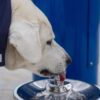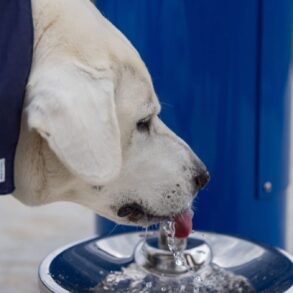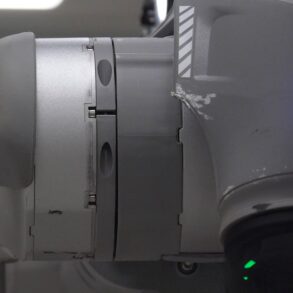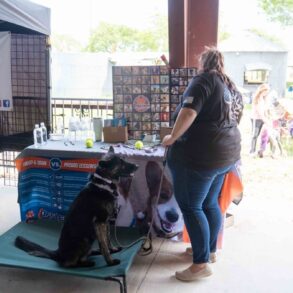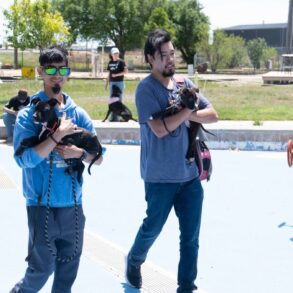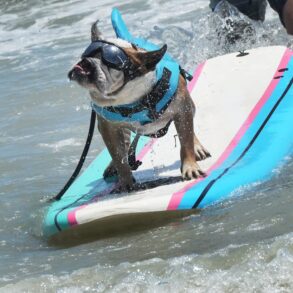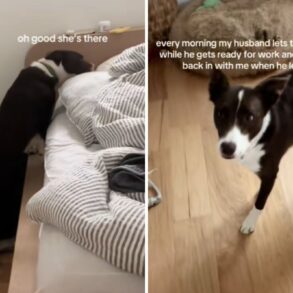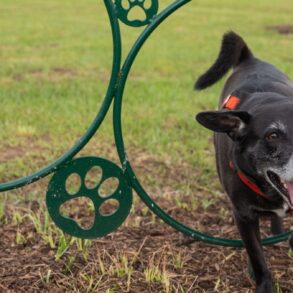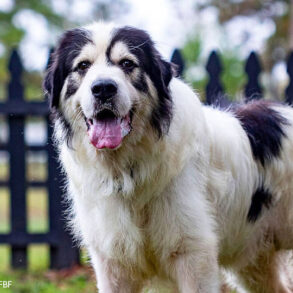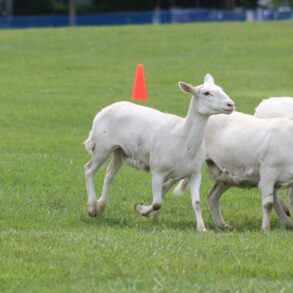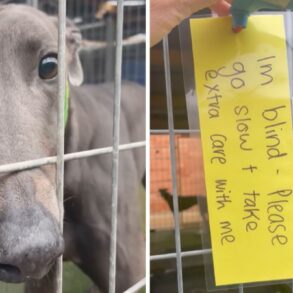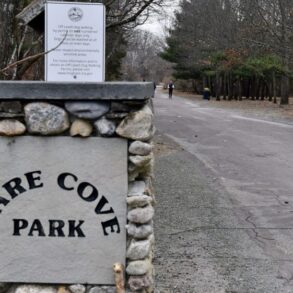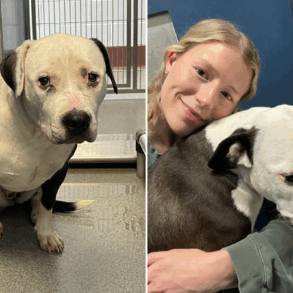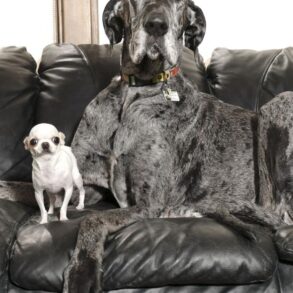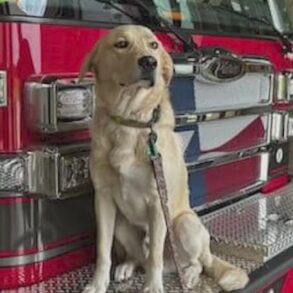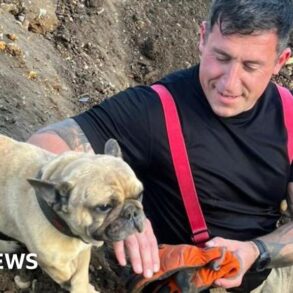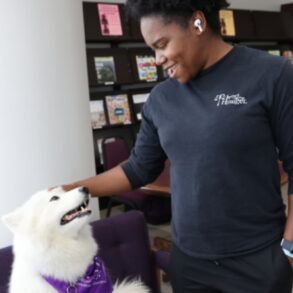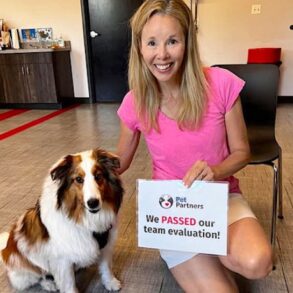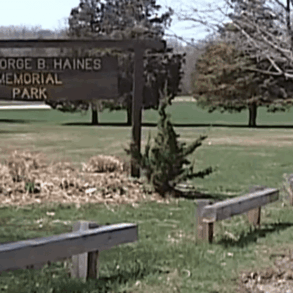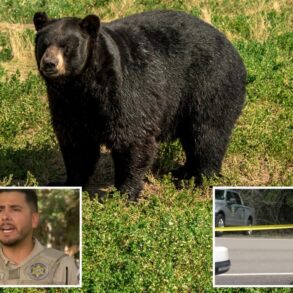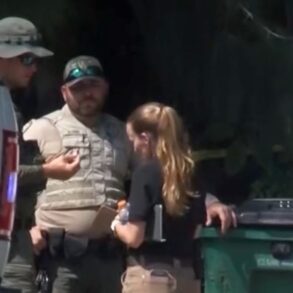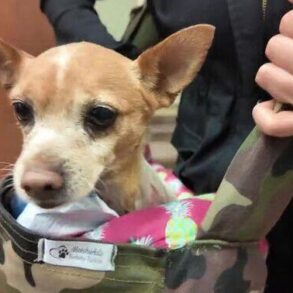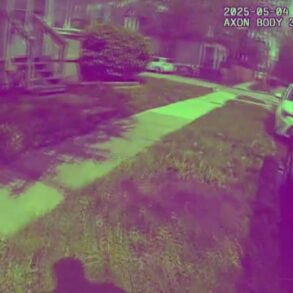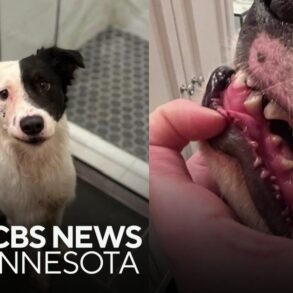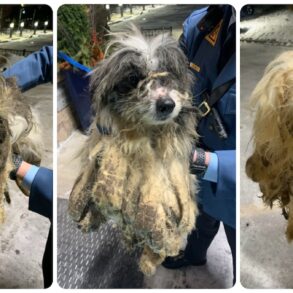Since December, four Northeast Ohio dogs and their human companions have been hot on the trail of invasive spotted lanternflies, sniffing out egg masses laid in the Cleveland Metroparks.
The team includes German shepherd Argent , black lab Juno, Australian shepherd cattle dog mix Rio and Bronco, an 8-year-old Cardigan Welsh Corgi.
Together, the team of dogs lead their owners through the Metroparks, nose to the ground following the scent of the spotted lanternfly egg masses.

J. Nungesser
/
Ideastream Public Media
The goal is to find and remove the eggs before they hatch in May, Metroparks Senior Conservation Science Manager Connie Hausman said. The invasive insects and their honeydew, the sticky substance the leave behind, can quickly become a nuisance for the public and parks alike.
“That honeydew then gets everywhere. It can cover park benches and picnic tables and yard patio furniture,” Hausman said. “That honeydew substance is also attractant to bees and wasps. So for where we want to enjoy the outdoors in our picnic areas we definitely … don’t want this making a mess of that space.”
The Cleveland Metroparks began working with volunteers to address the spotted lanternfly problem in 2020, Hausman said. This scent-tracking season will wrap up when the eggs begin to hatch later this month, but Metroparks is looking for new volunteers for next fall.
Park visitors who take the step to become volunteers are essential to the Metroparks’ operations, Hausman said.
“Protecting outdoors is really where the Cleveland Metroparks benefit the most,” she said, “because then we all work together as a community to protect and preserve and make sure that we can have access and appreciation for our park system.”
Bronco and Paige Malone
Bronco lives in Columbia Station with his owner Paige Malone. Like the rest of his teammates, Bronco participated in scent work, a dog sporting competition, before pivoting to spotted lanternflies.
“We already kind of had that knowledge of scent work,” Malone said. “Once we found out about the conservation, we all just kind of wanted to get into it. We love just taking walks with our dogs and being out and about, so then we thought, well, this would be kind of cool to do.”




J. Nungesser
/
Ideastream Public Media
Bronco and his teammates spent about nine months training before they got into the field, practicing the recognition of and ability to track down the egg masses.
Once on the hunt, he leads Malone through the grass and trees, alerting her once he finds something that smells familiar.
“He’ll do some type of behavior change where either,” like his head turns really quickly towards the tree ,” Maloe said, “or he’ll start putting his nose up in the air.”
After the eggs are identified, Malone scrapes them off the tree, squishing them to ensure they’re destroyed.
Since beginning work in December, Malone said the team has removed more than two-thousand egg masses from the Metroparks.
“But there’s about 30 to 50, I believe, eggs in each egg mass,” she said. So, when you times that by how many, luckily, we’ve done some good damage, us with the Metroparks.”
For Malone, knowing dogs are helping the environment is rewarding enough. For Bronco and his teammates, a few hot dogs, meatballs and freeze-dried minnows are even better.
“Some people might use toys and things like that too,” she said, “but food’s his big thing.”
Rio and Gail Samko
Columbia Station resident Gail Samko adopted 8-year-old Rio when he was just under a year old. Shortly after welcoming him to the family, she noticed he was shy and fearful of strangers, and searched for ways to build his confidence.
“We started with the scent and that’s what brought him out of his shell and he’s just been really, it really helped him so much being around people and getting working around strangers,” Samko said. “He’s probably got quite a few scent titles and one obedience.”




J. Nungesser
/
Ideastream Public Media
Since doing the scent work, Samko said she’s noticed a major shift in Rio’s personality.
“When he gets his harness on or he sees something with the treats, he’s ready to go. And when we go into the ring and stuff like that, he goes right into what he has to do and he’s done. He’s excited about that.”
When he’s off the clock, Rio’s favorite thing is some rest and relaxation.
“When I ask him if he wants to do scent work he’s ready to go. We practice a lot every other day outside and he’s ready to go,” Samko said. “When we’re done he goes on the couch and that’s it.”
Argent and Ginger Alpine
Argent is an 8-year-old German Shepherd who was initially trained to track down birch, anise, clove, and cypress. But when his owner, Ginger Alpine heard about the spotted lanternfly project, she knew they had to get involved.
“I wanted to really try that because I’ve always … wanted to be part of conservation,” she said. “So we immediately signed up to see if we would get approved.”




J. Nungesser
/
Ideastream Public Media
Argent enjoys the scent work, Alpine said, but spending time with his friends outside of their Litchfield home seems to be a highlight for him.
“He thinks a lot of times he’s just going on a walk … with his friends, because they’ve kind of all grown up together,” she said. “They’re not necessarily touchy-feely, like they want to play together, but they like to be around each other.”




J. Nungesser
/
Ideastream Public Media
The scent work allowed Argent to bond with his teammates, but Alpine said the work strengthened the bond between the two of them as well.
“We’ve gotten closer and I’m better at telling when he’s able to spot them when he caught the odor. I’m a little bit quicker at realizing that now” she said. “I’ve learned that I just kind of watch for those behavior changes. So yeah, we’ve definitely become a better team.”
Juno and Tara Gifford
Tara Gifford and her 8-year-old black lab Juno, from Sullivan, Ohio, were looking for activities that Juno could do on her own when the found scent work.
“She doesn’t always love being around a bunch of new dogs, so some of the sports environments were a little tough for her,” Gifford said. “Scent is something that dogs do — it’s more of an individual kind of sport, so that seemed to work well for her.”
But when it comes to her team of spotted lanternfly trackers, Juno is comfortable and ready to get to work once she’s on site.
“She enjoys the game quite a bit. When I get her out of the car and I put her equipment on She’s raring to go,” Gifford said. “She’s pulling on the leash, she’s pulling to wherever she can get going with her nose.”




J. Nungesser
/
Ideastream Public Media
Juno’s nose continues to impress, Gifford said. While searching for eggs at the Cleveland Metroparks Zoo, Juno alerted to a spot that seemed questionable to Gifford.
“She went over and she did her nose alert on this metal tag that was on one of the trees, and I thought, that’s strange, why is she doing that there?” Gifford said. “I thought maybe the metal was kind of a tipping thing for her. But when I went over there and flipped up that sign, there was spotted lanternfly egg mass right near that metal tag.”
Juno is a good scent dog who’s eager to get to work, but using her talents to prevent an invasive species from spreading is even more special, Gifford said.
“It’s really fun to do really most anything with my dog, but to work together as a team on this sort of thing is kind of satisfying,” she said. “It’s fun to compete and win ribbons, but it’s also more meaningful … when you’re doing something like this for the environment and the community.”
This post was originally published on this site be sure to check out more of their content.


